

| Alastair Reynolds has his own Web page. | ||
| Click on a book's image or title to order from Amazon.com |
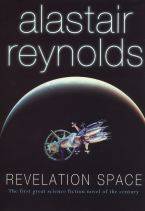
Revelation Space
Victor Gollancz (UK), HC, © 2000, 476 pp, ISBN #0-575-06875-2Reviewed September 2000
One of the new wave of British hard SF authors, along with Ken MacLeod, Revelation Space is Alastair Reynolds' first novel (and, as I write this, it isn't yet available in the US). The plot is complex, and the technology high.
It's the 26th century and humanity has colonized other worlds. No sentient life has yet been found, although remnants of several extinct civilizations have been discovered. There are also the Shrouders, presumed aliens who live behind impenetrable black spheres in stationary space, and the Pattern Jugglers, living swarms of memory which drift on some oceanic worlds and which will make modifications to a person's mind if desired.
Dan Sylveste is the son of the famous, late Calvin Sylveste (whose Turing-compliant simulation he has on a memory chip to consult with on occasion). Dan is investigating the extinct race called the Amarantin on the planet Resurgam, a dust bowl with a small colony whose supporting starship left the system years ago after a revolution on the planet. Sylveste is convinced that the event which destroyed the Amarantin could affect humanity as well, but just as he's on the edge of making a discovery, another revolt leaves his political rival in power, and himself in prison.
Meanwhile, the lighthugger Nostalgia for Infinity is travelling to the planet Yellowstone in search of Sylveste, with whose help they hope they can cure their captain, a "chimeric" (cyborg) whose flesh and machinery are under attack from a technological virus, and who is kept in suspended animation to slow the virus' effects. Ilia Volyova is forced to kill her gunnery officer after he goes insane thanks to interfacing with the gunnery computer.
Finally, on Yellowstone, Ana Khouri is a former soldier from the planet Sky's Edge, who was accidentally sent to Yellowstone following an injury. As faster-than-light travel doesn't exist, she's been separated from her husband by forty years, and she's taken up work as a contract assassin. After her latest mission, she is forcibly recruited by the mysterious Mademoiselle, who wants to hire her to kill someone, and wants her to apply for the gunnery job aboard the Nostalgia for Infinity.
And so it begins.
Revelation Space is, at its core, a mystery about what happened to the Amarantin. But the aims of the three characters - Sylveste, Volyova, Khouri - conflict at times and blend together at other times, complicating the exploration of the mystery. Never mind that each character has a backstory which contributes its own complications to the plot. Moreover, each character has certain kinds of leverage which he or she can bring to bear to get what s/he wants, as Sylveste demonstrates when the crew of the Infinity tries to strong-arm him into doing their bidding. You should have a certain appreciation of machinations which one person turns upon another in order to fully enjoy this book, as much of it is about interpersonal maneuvering on two or three levels.
(In many ways, its plot resembles that of Vernor Vinge's A Deepness in the Sky, and fans of that book will probably enjoy this one.)
The writing style of the book is interesting: There are some scenes which last for several pages, and others which feel like "half-scenes", ending before the climax of the scene has really been reached. Early on this is frustrating, as the book cuts away just as something is getting good, but as the three threads of the novel coalesce, it turns out to work fairly well. The last third of a book is a real page-turner.
Ultimately, of course, any book of this sort relies only partly on its setting (intricate and intriguing) and events (enjoyable, if sometimes frustrating), but doesn't fully work unless the payoff at the end of the mystery is worthwhile. Revelation Space delivers a payoff which is adequate, but not as mind-shattering as the build-up implies, which is a fundamental problem with SF novels trying to offer a kind of transcendence which hasn't been seen before (Charles Sheffield's Summertide trilogy is an example of a story of this sort with an especially poor payoff). But it's still interesting and the book is certainly worth reading. Its biggest problem is that it ends a little too soon, as there are still a few threads which don't feel entirely resolved.
This is an impressive first novel and hard SF fans everyone ought to enjoy it.
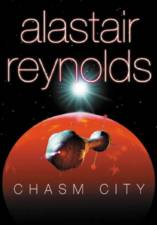
Chasm City
Victor Gollancz (UK), HC, © 2001, 524 pp, ISBN #0-575-06877-9Reviewed November 2001
Did you enjoy Revelation Space? Well, hold on, because Reynolds' second novel, Chasm City, is even better.
Tanner Mirabel is a mercenary, who on his homeworld of Sky's Edge was hired out to arms merchant Cahuella to coordinate his security team and protect his wife, Gitta. But Mirabel failed, tragically, and now he's pursued Argent Reivich, who killed them both, to the planet Yellowstone. Since space travel is slower-than-light, this means Mirabel spent 15 years in deep freeze. When he awoke, he discovers he was infected with a virus which causes him to dream the life of Sky Haussman, the multi-murderous founder of Sky's Edge.
Mirabel pursued Reivich to Chasm City, a once-glorious metropolis which seven years ago was struck with the Melding Plague, which caused all of the high-tech in the city to begin behaving differently, no longer under human control. This is a problem when humans, building, and the whole city and orbiting space colonies are riddled with high-tech gizmos and nanotechnology. The result was economic and social chaos, followed by extreme social stratification in a gothic nightmare of a city.
Mirabel works his way up from the Mulch - the lower and poorer levels of the city - to the Canopy, where the buildings have grown wildly and in ways never planned by humans, and he becomes caught between factions of postmortal interests among the rich. Still, Mirabel is clever and persuasive and manages to keep up with their games as he continues to chip away at his own goal of finding and killing Reivich. But there's something Mirabel doesn't realize, something he's lost, and it seems like his dreams of Sky Haussman are trying to tell him something. And Chasm City is about how it all comes together.
Although initially a tale of obsessive revenge, Chasm City eventually evolves - quite naturally, actually - into a story of redemption of several of the characters, and of the city itself. Mirabel is in many ways your standard ultra-competent protagonist, but there is something about him which makes him essentially different, and raises some fundamental moral questions about the forms redemption can take, and who gets to decide whether someone's been truly redeemed. The ultimate issue is left as one for the reader to decide, which is as it should be.
Reynolds' first novel was once described as "cybergoth", and that's not an unfair assessment, as his settings are dark and often claustrophobic, the psychological and political power-plays among his characters can range to the byzantine, and there's always the specter of innovative - and sometimes not-well-understood - technology lurking in the background (if not the foreground) waiting to change all the rules of the game. It's not always high-tension stuff, but there's always a low-level feeling that something funny is going on, and you're not quite sure what it is. It gives Reynolds' universe this strange feeling of being a wondrous place but you're not sure you'd actually want to live there.
Despite the book's name, the settings of Sky's Edge and the generation ships which Haussman lived on while travelling there are rendered just as clearly - if not more so - as Chasm City. Reynolds effortlessly throws in the experience of living one's whole life on a spaceship, and an alien ecology, into the mix, rarely playing up his cool ideas but instead staying sharply focused on the story. If there's a flaw here, is that sometimes the flashbacks are more interesting than the main plot.
Best of all, there are some great secrets revealed along the way, and the fact that I saw two of them coming well before Mirabel did (although one of them was clearly intended to be figured out ahead of time) didn't detract from their contribution to the story at all. (This is as it should be; writers shouldn't always have to be three steps ahead of their readers.) As a result, all the plot elements tie together quite nicely at the end, and Reynolds even introduces some new background elements into his universe which might contribute to a future novel (even as Chasm City was itself a minor setting in Revelation Space).
Ultimately, though fans of strong character-based fiction might find this book not to their taste, fans of high-tech intrigue and science fictional mysteries should find it highly entertaining. I can't wait to see what Reynolds comes up with next.
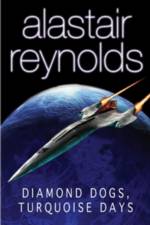
Diamond Dogs, Turquoise Days
Victor Gollancz (UK), HC, © 2002, 231 pp, ISBN #0-575-07526-0Reviewed December 2003
This book contains a pair of novellas set in Reynolds' Revelation Space universe.
"Diamond Dogs" is in the venerable mold of humans attempting to penetrate an alien object, which presents puzzles to them to obstruct their progress. Richard Swift is approached by his longtime friend Roland Childe - who has also been missing for decades - to embark on an expedition to an alien world to attempt to penetrate a tower called the Blood Spire. With them are several trained specialists, notably a star-travelling Ultra, and a doctor who specializes - scandalously - in turning humans into cyborgs. As well as Richard's ex-wife Celeste, who had been modified by the Pattern Jugglers and has an aptitude for mathematics.
Stories such as this are notoriously difficult to write - after all the build-up, how can the payoff possibly live up to expectations? Reynolds does the smart thing and focuses on the characters and their attitudes throughout, making it a story about obsession and how future technology could fuel and twist that obsession, rather than being all about the Blood Spire and its secrets. That said, I didn't find it entirely successful on that score. Richard's background as a character was too skimpy to entirely pull me in, and ultimately I think the conflicts developed among the main characters could have been spun off in a more complicated direction than the story ultimately took.
"Turquoise Days" is about events on the planet Turquoise, one of many worlds which hosts a culture of Planet Jugglers, non-sentient (it seems) biological devices which inhabit the planet's ocean, and which occasionally invite humans to enter their nodes where they are sometimes technologically enhanced - and other times absorbed into the Juggler mass. Naqi and her older sister Mina are researchers helping to study the Jugglers, both aspiring to rise to a prominent position in Turquoise's research group. Naqi feels overshadowed by Mina, and when news of an approaching Ultra ship to the mostly-isolated Turquoise blacks out planetary communications, and at the same time the Jugglers start acting up, the sisters take a big risk, leading to one of them having to figure out how to deal with the situation created by the Ultra' arrival two years later.
"Turquoise" is both more powerful in its characterizations than "Diamond", but it presents more interesting idea-driven situations. Getting a close look at the Jugglers - who feature significantly but distantly in Reynolds' novels - is a lot of fun, as is the human culture that's sprung up around them. But what makes the story hum is the set-up of Mina and Naqi's studies and how it pays off when the Ultras arrive. The motivations of the visitors, and what the sisters do about them is the center of the tale.
Both stories in this volume are very dark, as Reynolds' stories generally are, and the endings have a pronounced melancholy note, though they both work in their ways. But it's Reynolds' vivid portrayals of his universe and elegant storytelling that make the effort worthwhile.
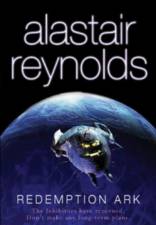
Redemption Ark
Victor Gollancz (UK), HC, © 2002, 567 pp, ISBN #0-575-06879-5Reviewed November 2002
Redemption Ark is a sequel to Reynolds' first novel, Revelation Space. Newcomers to Reynolds' novels will want to read that one before tackling this one. Reading Chasm City isn't strictly necessary as it's not the same overall story arc (though it's very good in its own right).
Nevil Clavain is a Conjoiner, a group in humanspace who believe in evolving beyond individual limitations by linking their minds via technology. They've been fighting a war around the planet Yellowstone (home of Chasm City) for decades against the Demarchists. The Conjoiners are winning the war, but change their priorities when they learn of the Wolves - ancient alien machines coming to sterilize humanspace as they have other sentient species. Clavain is recruited by the secretive and ruthless Skade to help her mount an expedition to a nearby star to reclaim some hell-class weapons the Conjoiners lost centuries earlier, planning to take the weapons along when the Conjoiners abandon this part of the galaxy. Clavain doesn't find Skade's arguments entirely persuasive, and defects, hoping to have someone else beat the Conjoiners there.
Meanwhile, Ilia Volyova and Ana Khouri and their mutated ship, the Nostalgia for Infinity, are near the planet Resurgam, where the Wolves - whom they know as the Inhibitors - have shown up and appear bent on destroying humans in that system. They hope to evacuate Resurgam - a daunting task, as Ilia is considered a war criminal on that world - or, failing that, to destroy the Inhibitor agents using the cache weapons which the Conjoiners want to recover.
This puts the three parties on a collision course against the backdrop of the Inhibitors, with some interesting supporting characters: Antoinette Bax and Xavier Liu, caught up in the web when Bax tries to bury her father in a gas giant. Scorpio, a genetically engineered pig and criminal mastermind of Chasm City. Felka, close friend of Clavain and the result of some genetic experiments centuries earlier. And H, a mysterious power broker in Chasm City who arranges Clavain's mission to Resurgam. (It's broadly hinted that H is Tanner Mirabel from Chasm City.)
Redemption Ark returns to the grand space operatic feel of Revelation Space, moving away from the gritty personal themes of Chasm City. Though this is sure to delight unabashed fans of space opera, I think it makes it a weaker novel than CC. No longer the protagonists, Volyova's and Khouri's story feels a bit too mechanical. The novel belongs to Clavain, as he's the one who has to make the tough decisions, and being a soldier he doesn't shy away from it. Clavain could be just as compelling a character as Tanner Mirabel, but he has to share time with so many other characters he can't quite reach that plateau.
Ultimately, what makes RA not as good as I'd hoped it that it really is a bridging novel from Revelation Space to the final novel in the arc, Absolution Gap. Characters' story arcs - particularly Clavain's and Khouri's - are left dangling at the end of this book. Unlike RS, there's little sense of closure, of things accomplished. What we have here is a means to the end, and the end is yet to come.
What really does work in the story is that the mystery of the Inhibitors is peeled back a little more, and Reynolds provides an entirely satisfying explanation for why the Inhibitor machines behave as they do. Which considering they've been destroying interstellar civilizations for billions of years is no small task.
Somewhat less successful is the collision course between the two forces of "heroes", led by Clavain and Volyova. Each of them has their own goals, which are fairly admirable, but neither is willing to surrender the cache weapons. The conflict between them is the centerpiece of the book's climax, and as you'd expect it's pretty flashy. But the transition to the segment following the battle is less successful and feels a bit rushed.
But there are plenty of threads left out there to resolve in the next installment, and I'll certainly be back for more. I think the key will be to meld the heavily plot-driven nature of the story to this point with the strong character elements of Chasm City, to make Clavain's story in particular entirely successful. Let's hope Reynolds can pull it off!
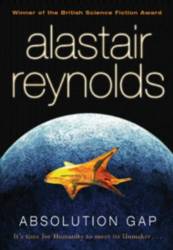
Absolution Gap
Victor Gollancz (UK), HC, © 2003, 565 pp, ISBN #0-575-07434-5Reviewed March 2004
Absolute Gap completes the trilogy which begins with Revelation Space and continues in Redemption Ark (with Chasm City as a related but standalone tale). Actually, this one makes it clear that the "trilogy" is really a trio of fairly tightly linked novels, but each primarily concerned with its own plots and themes, with the shared elements primarily as backdrop. As usual, Reynolds shies away from the typical approach to such things.
23 years after the close of Redemption Ark, Clavain and Scorpio are still running their colony on Ararat, waiting for either the Conjoiners or the Wolves (a.k.a. Inhibitors) to contact them, with the Nostalgia for Infinity and its consciousness sleeping in a nearby bay. Contact comes with the surprise arrival in an escape pod of Ana Khouri, onetime resident of the Infinity, who tells them that things have come to a head, and on top of it all Clavain's Conjoiner nemesis Skade is on-planet with Khouri's daughter Aura - an unborn girl touched by the superhuman and possibly the key to humanity surviving the Wolves.
"Meanwhile", 50 years in the future and many light years away, a young woman named Rashmika Els lives on the moon of Hela, orbiting the gas giant Haldora. Discovered a hundred years earlier by an unbalanced explorer named Quaiche, Quaiche organized a religion centered around Haldora, whose occasional peculiar behavior Quaiche - infected with a religious indoctrinal virus - thinks hides the face of god. The Helan churches inhabit slow-moving cathedrals which walk the equator of Hela to constantly keep Haldora in view.
Rashmika embarks on a journey from the fringes of her frozen world to the cathedrals to find out what happened to her brother years earlier. Rashmika has a rather special talent which puts her in the eye of Quaiche's right-hand man. And unsurprisingly, Hela is of import to the struggle between humanity and the Wolves, which means Rashmika is also on a collision course with the crew of the Nostalgia for Infinity.
Absolution Gap is an impressive accomplishment all around, but especially in its idea content: One of the book's throw-away ideas, about the nature of the extinct indigenous species of Hela - is a thrilling concept for fans of Stephen Jay Gould's Wonderful Life. Beyond that we have Quaiche's bizarre religion - and the explanation for the phenomenon which prompted it; the mysterious perfect bridge which spans Absolution Gap, a chasm which runs from pole to pole on Hela; Aura and her mystique; Rashmika and her special gift; the captain of the Infinity, melded to his ship and somewhat deranged; and the weapons being employed in the fight between humans and Wolves.
At a character level, the main figures are Rashmika and Scorpio. Rashmika is a curiosity with an interesting story to be revealed. Scorpio, on the other hand, is what he is: An aging, sentient, bipedal pig, and former criminal mastermind, now the titular leader of a human colony and friend of Clavain. Scorpio knows he's nearing the end of his life, and find the upheaval of the colony he led to be far more disturbing than he'd expected - he never thought he'd become a statesman, much less like it. His struggles within his little society are the most interesting character bits in the book.
With all of this going on, the actual war with the Wolves feels almost like an afterthought, even though it's the driving and pervasive event in human history throughout the decades in which the novel occurs. Reynolds presents some tough choices for his heroes in dealing with the situation - tougher than one might expect, in fact. And things are indeed wrapped up by the end, but not in at all a conventional manner.
Absolution Gap stands on its own as a towering piece of science fiction, and as a thrilling conclusion to the Inhibitor sequence. An excellent work all around.
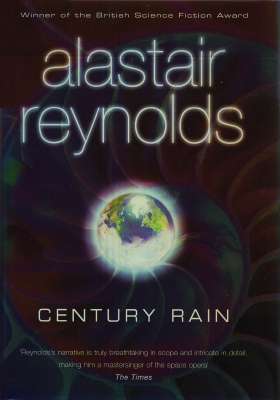
Century Rain
Victor Gollancz (UK), HC, © 2004, 503 pp, ISBN #0-575-07436-1Reviewed March 2005
Century Rain is Alastair Reynolds' first novel outside his universe of Revelation Space, and it's a standalone piece which combines his flair for high-tech suspense drama with the essential elements of alternate history.
In 1959 Paris, Willard Floyd is a private detective and sometime jazz musician. Despite the defeat of the Nazi invasion of France in 1940, Floyd is disturbed by the increasingly martial nature of the government and police, and by the imminent death of his favorite form of music. He and his partner, Andre Custine, are hired to investigate the murder of Susan White, American tourist, who fell from her apartment balcony and whose death has been ruled an accident by the police. Her landlord, however, is convinced that she was in fact killed.
Verity Auger is an archaeologist in the 23rd century, exploring the ruins of Paris, one of the few accessible places on Earth since it was ravaged by the Nanocaust two centuries earlier. A mistake on a mission costs the life of one of her students, and she is forced to choose between open trial and having it hushed up if she'll help look into a problem for a secret arm of the government. In Augur's world, humanity is divided between two groups: The Slashers, who have embraced nanotechnology and who have discovered a network of wormholes connecting the galaxy, and the Threshers - Auger's people - who believe that nanotechnology will eventually run unchecked and destroy humanity, and who have rejected its excesses. The two groups are on the verge of war - again - as Auger embarks on her mission.
The Slashers, it turns out, have discovered several huge artificial objects around the galaxy which seem to contain planets. At the same time, the Threshers have discovered the end of a hidden wormhole in one of the moons of Mars, and found that its other end lies on a world which seems a near-perfect replica of 20th century Earth. But there's something rotten going on in that world, which Auger has to figure out, and which as you might guess involves Floyd as well.
Century Rain's plot is a collection of "almost great" ideas wrapped in some terrific atmosphere and writing. Floyd and his world seem downright real, even though it's not really alternate history and the ramifications of its deviation are not the central thrust of the story. The tensions of the political and social situation, Floyd's life on the margins of society, it all feels very gritty and real, and the book wouldn't have worked at all without that.
The larger story is interesting because it's as if Reynolds created a set of contrivances to limit how far the characters could go, to keep the technology from going out of control, and it basically works. He does unfortunately resort to the "limits set by a presumed-extinct alien species who have their own unknowable reasons for creating what they left behind" device, which at this point is perhaps one which science fiction writers as a group should shelve for a few decades, as it's always disappointing when the whys and wherefores aren't revealed. But given that Auger and her people have this universe to play in, it's a rather fun one. Their ability to interact with the "Earth-in-a-bottle" is limited by certain realities involving the wormhole, which places them in an interesting position when it comes to exploring the threat to that world without their high-tech gizmos. Of course, taking Auger out of her element in this way is exactly what spurs the characterizations of the story.
Auger starts out as roughly sympathetic - she's being manipulated and neither she nor the reader cares for it. She starts seeming like a whiny crybaby for a while, but once the fecal matter hits the rotating oscillator she gains an investment in her mission beyond self-interest - she's gotten involved and is working towards the right end because it's the right thing to do. Floyd, then, is instantly likeable, an intelligent and suave individual in a bad situation of his own choosing, the right man at the wrong time, frustrated that there's nothing he can do to change it as he sees the world going to hell around him. Finally given that opportunity, he rises to the challenge despite being repeatedly told it's not his fight and not his business.
The first 300 pages of the story are arresting, as the layers of the mystery are peeled back, the characters meet, and the situation becomes dire. Strangely, the last 200 pages are not as successful, even though they comprise the resolution and climax of the story. After a hectic and tension-filled series of journeys, the Slasher/Thresher conflict comes to the forefront, along with the plan of the villains of the piece, but it ends up being a rather unfulfilling chase sequence leading to the final resolution. And indeed, our heroes make their ultimate choices, but we don't really see the results of those choices, leaving the character development of the story feeling not quite fulfilled. Floyd, in particular, is left on the cusp of some grand decisions, and the fade to black occurs just a little too soon, I think.
It's hard to point at just where the story went wrong. Perhaps it was simply too ambitious, or that the last 100 pages focused too much on the mechanics of plot resolution and not enough on the character development. Maybe another 30 or 40 pages were needed to provide a suitable denouement (denouement so often seems to get shoved aside in science fiction). While overall I enjoyed the book, and Reynolds continues to demonstrate that he's one of the most capable imagineers in the genre in both originality and complexity, Century Rain is not as successful as some of his earlier works. It needed a little more... something.
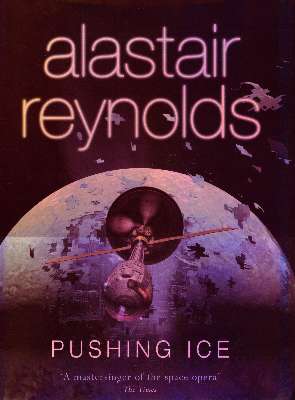
Pushing Ice
Victor Gollancz (UK), HC, © 2005, 457 pp, ISBN #0-575-07438-8Reviewed January 2006
As a rule, I'm not much of a fan of near-future science fiction. It's usually insufficiently imaginative for my tastes. However, Alastair Reynolds is one of my favorite authors, so I was perfectly happy to give Pushing Ice a try. It turned out better than I had imagined it might!
The book opens in the far future, where Chromis Pasqueflower Bowerbird, a representative to the Congress of the Lindblad Ring, is trying to persuade her colleagues to send a token of appreciation to the Benefactor of the human race, she who inspired them to become what they are. The problem is, they don't know where she is or if she's still alive. But Chromis has a plan.
Cut to the year 2057. Bella Lind is captain of the ice asteroid pusher Rockhopper when something amazing happens: Janus, a moon of Saturn, has unexpectedly broken orbit and is heading out of the solar system at relativistic velocities, apparently headed for the star Spica. The Rockhopper is the ship best-positioned to catch up to Janus, spend a few days there, and then get home. There are complications, though: The Chinese are planning their own mission; Jim Chisholm, Bella's right-hand man, has a life-threatening illness and needs to return to Earth as soon as possible, and his replacement, Craig Schrope, is a hard-nosed company man; and the crew is divided as to whether they really want to go.
Of course, they go. But they encounter many problems along the way, including an accident which kills one crewmember and leaves chief engineer Svetlana Barseghian worried that they don't have enough fuel to get to Janus and then return home. Remotely, the company which owns Rockhopper assures them that they do, but the seeds of mistrust have been sown. Bella is inclined to believe the company, while Svetlana is frustrated that her friend refuses to see otherwise.
Meanwhile, it turns out that Janus is heading for a large structure of struts sitting in the Janus system - perhaps a sign of humanity's first extraterrestrial contact.
Things go from bad to worse, and when they approach Janus they find that the moon has played a trick on them, and that they almost certainly can't return home. So Bella orders that the ship stay at the moon and with some crafty help engineers that this happen despite the will of the majority of the crew - including Svetlana. Rockhopper lands on Janus and heads out of the system with a hundred-odd humans trying to eke out a precarious living on a moon which has turned out to be a large, unmanned, and mysterious starship.
And that's just the first third of the book.
Pushing Ice is at once a grand and a claustrophobic novel, with a vast cast that ultimately boils down to a study of the long-term conflict between the two women - both natural leaders - in a high-pressure environment. While that first third of the book is in many ways fairly routine near-future space exploration, it's crucial to set up the relationships among the characters, and laying a few long-term plot threads. The second third sees the little colony through to the apparent end of their journey, where they get their first taste of what's waiting for them at the far end. And the final third opens up the scope of the story to provide perspective on intelligent life in the universe, what you can accomplish given a very long time scale, and bringing things back to the opening sequence with Chromis.
I was pretty happy that I more-or-less figured out part of what the Spica structure was for, but Reynolds is clever and while that aspect is the means, it's not the end that's revealed later in the book. Reynolds also employs his far-future introductory milieu in a very clever way, braiding it into the main story in an unexpected and rewarding manner.
The characterizations are pretty good, although not crisp to the point of really standing out. Bella and Svetlana's falling out feels just a little bit artificial, a reaction a little too personal despite a cause that feels not personal enough. This undercuts the story somewhat since it's crucial to driving the overall plot and the reader's emotional reactions. The basically good nature of several other characters, moderating the main pair in different ways, adds some complexity which helps disguise this flaw, however.
As usual, Reynolds' high-tech ideas - and there are several - are nifty and deftly employed, and mixing them with the relatively low tech of Rockhopper is also very well done.
Most importantly, the story is a real page-turner, and by the midpoint it's difficult to put the book down, employing both "what happens next?" and "how are they gonna get out of this one?" tactics.
Much of today's high-tech science fiction (Charles Stress' Accelerando, for example) is concerned not just with what's coming down the road, but with whether ordinary humans can carve out a meaningful space when the natural endpoint of our development is into something not really human anymore. Pushing Ice considers the question of what's meaningful to us in the very long term, and does so in a thoughtful and thought-provoking manner. Its fundamental optimism in the face of many threats and dangers helps make it an all-around enjoyable read.
I think it's his best book since Chasm City.
hits since 24 September 2000.